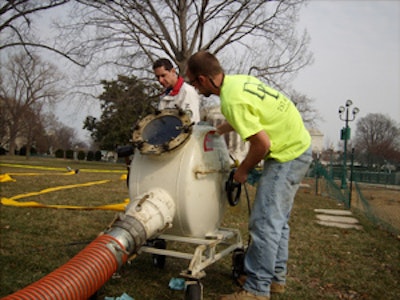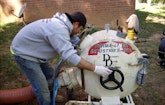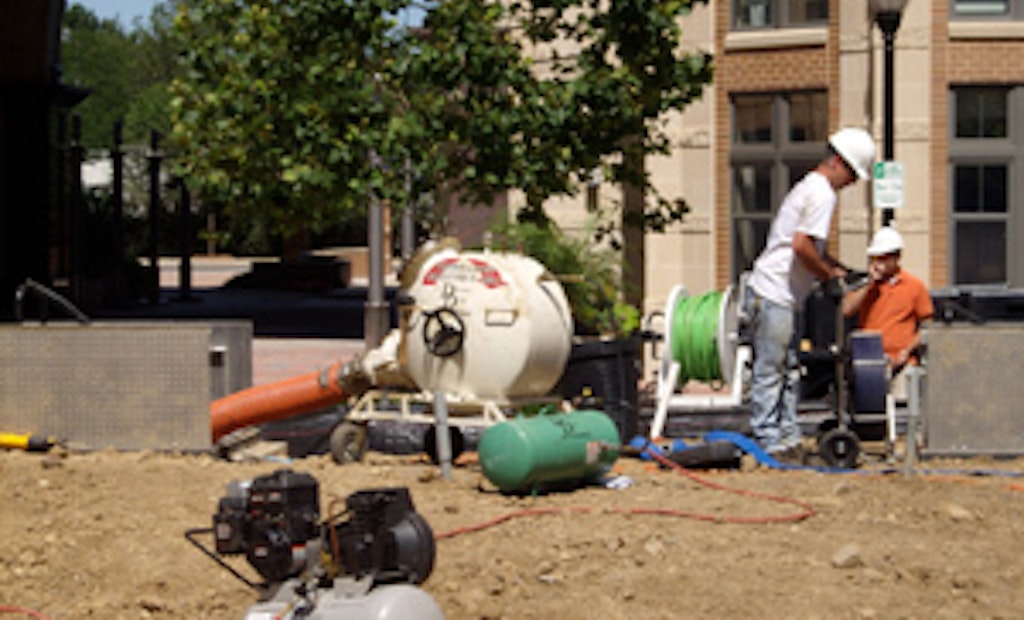Interested in Relining/Rehab?
Get Relining/Rehab articles, news and videos right in your inbox! Sign up now.
Relining/Rehab + Get AlertsWhen Nick Santoni established Dynamic Drain Technologies LLC in 2008, he took a calculated gamble centered on one piece of equipment: a Perma-Lateral pipe relining system made by Perma-Liner Industries Inc.
Four years later, it’s clear the gamble paid off. The Virginia Beach, Va.-based company now provides additional services, including waterjetting, pipe bursting and pipeline inspection and location services to residential, commercial and municipal clients in about a dozen states in the Mid-Atlantic region.
But cured-in-place (CIP) lateral pipe relining remains a critical core service, says Santoni, president and chief executive officer. The system relies on air-inverted, cured-in-place pipe (CIPP) and ambient-cure resins to reline 2- to 8-inch-diameter pipes without stretching the liner and while negotiating 22-, 45- and 90-degree bends.
“Our whole business model is based on our two Perma-Lateral systems,” he explains. “It’s our core product, and provides the highest profit margins. Everything we do revolves around them.”
Santoni started his business when he realized no one else in the Mid-Atlantic region of Virginia was offering alternatives to open-cut lateral replacements.
“I saw a large gap – basically from Maryland down to South Carolina – where no one offered this technology,” he says. “And these states contain some of the nation’s oldest infrastructure, with a lot of failing laterals.
“Plus, while doing market research, I found that many civil engineers, utility site contractors and defense contractors at military bases were using out-of-town contractors for pipe relining – and paying a higher price than what I could charge for delivering the same service,” he adds.
Santoni lauds the Perma-Lateral system’s productivity. He says his crews can repair up to 300 feet of pipe per day, without invasive and destructive excavation. That improves productivity and profitability more than any other machine the company owns.
“It allows us to make a large amount of money in a short period of time, more than any other pipe-fixing equipment I can think of,” he says. “It also brings job site liability down by about half because there’s no heavy equipment involved … because there’s no invasive digging or heavy-structure removal.”
The Perma-Lateral also reduces environmental ramifications on certain projects, which makes the company a more attractive option to customers. For instance, one of Dynamic Drain’s specialties is relining roof drainpipes that often are encased in asbestos columns. Traditional rehabilitation methods would involve breaking down the columns and removing the asbestos, which is a time-consuming, expensive and risky job.
“But the Perma-Lateral is light enough to take on top of buildings, where we reline from the top down – and don’t require any asbestos abatement,” Santoni says. “We’ve done up to 10 35-foot-high stacks a day, and we’ve also done eight 85-foot-lengths (of drainpipe) in a week.”
Santoni also points out that the Perma-Lateral reduces the size of typical work crews to three to five people from 10, which in turn decreases meal and lodging costs on out-of-town jobs – and frees up employees to go set up other jobs ahead of time. He estimates his overhead costs on projects are two-thirds lower than if he used conventional open-cut pipe replacements.
Pipe relining also enables Dynamic Drain to win jobs it otherwise might not obtain using conventional methods. As an example, Santoni points to a job where his crews rehabbed 1,000 feet of sanitary drain lines at a U.S. Marine Corps mess hall without interrupting the meal schedules for 3,000 soldiers during the 10-day project.
In addition, the company often works on historic federal buildings, which can be a nerve-wracking experience.
“They’re high-risk, high-reward projects,” Santoni notes. “Screw it up, and you’re in a lot of trouble.”
But with the right equipment in tow, those jobs represent a calculated gamble he’s willing to take.








